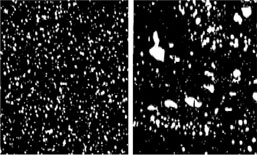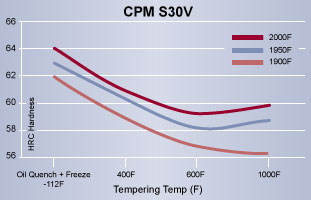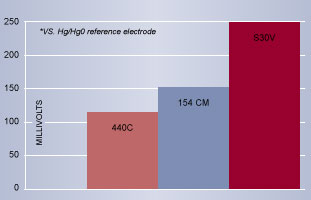Data Sheet - CPM S30V
| Typical Composition | ||||
| C | Cr | Mo | V | |
| 1.45 | 14.00 | 2.00 | 4.00 | |
CPM® S30V® is a martensitic stainless steel designed to offer the best combination of toughness, wear resistance and corrosion resistance. Its chemistry has been specially balanced to promote the formation of vanadium carbides which are harder and more effective than chromium carbides in providing wear resistance. CPM® S30V® offers substantial improvement in toughness over other high hardness steels such as 440C and D2, and its corrosion resistance is equal to or better than 440C in various environments.
The CPM® process produces very homogeneous, high quality steel characterized by superior dimensional stability, grind ability, and toughness compared to steels produced by conventional processes.
The typical applications include long -wearing cutlery, plastic injection and extrusion feed screws and dies, non-return valve components, pelletizing equipment, and wear components for food and chemical processing.
Machinability and Grind ability: In the annealed condition, CPM® S30V® is much easier to machine than CPM® S90V® and is comparable to that of D2. Similar grinding equipment and practices used for high speed steels are recommended. “SG” type alumina wheels or CBN wheels have generally given the best performance with CPM® steels.
 |
|
| Conventional Steel | CPM® Steel |
Mechanical Properties
| Grade | Impact Energy |
| CPM® | 10.0 ft. lbs |
| S30V® | |
| 154 CM® | 2.5 ft. lbs |
| 440C | 2.5 ft. lbs |
Toughness (Transverse Charpy C-notch Testing)
These higher transverse toughness results indicate that CPM® S30V® is much more resistant to chipping and breaking in applications which may encounter side loading. Its toughness makes it better for bigger blades in knife making.
| Grade | % |
| CPM® | 145 |
| S30V® | |
| 154 CM® | 120 |
| 440C | 100 |
Edge Retention (CATRA Testing Relative to 440C)
The CATRA test machine performs a standard cutting operation & measures the number of silica impregnated cards which are cut. It is considered a measure of relative wear resistance, as compared to 440C.
This data sheet is for informational purposes only. Alloy characteristics are subject to change due to chemical composition and/or processing. We do not certify the material’s suitability for specific applications.
Thermal Treatments
Forging: 2100°F (1150°C) do not forge below 1750°F (950°C).
Annealing: Heat to 1650°F (900°C), hold 2 hours, slow cool no faster than 25°F (15°C) per hour to 1100°F (595°C), then furnace cool or cool in still air to room temperature.
Annealed Hardness: About BHN 255
Stress Relieving
Annealed Parts: Heat to 1100-1300°F (595 - 705°C), hold 2 hours, then furnace cool or cool in still air.
Hardened Parts: Heat to 25-50°F (15-30°C) below original tempering temperature, hold 2 hours, then furnace cool or cool in still air.
Straightening: Best done warm 400-800°F (200-430°C).
Hardening
Preheat: Heat to 1550-1600°F (845-870°C), Equalize.
Austenitize: 1900-2000°F (1035-1095°C), hold time at temperature 15-30 minutes.
Quench: Air or positive pressure quench (2 bar minimum) to below 125°F (50°C), or salt or interrupted oil quench to about 1000°F (540°C), then air cool to below 125°F (50°C).
Temper: Double temper at 400-750°F (200-400°C). Hold for 2 hours minimum each time. A freezing treatment may be used between the first and second tempers. Freezing treatments help to attain maximum hardenability and must always be followed by at least one temper.
NOTE: For optimum stress relieving, CPM® S30V® may be tempered at 1000-1025°F (540-550°C). Tempering in this range may result in a slight decrease in corrosion resistance.
Size Change: +0.05 to +0.10% when fully martensitic. The presence of retained austenite may reduce the net growth. When tempering at 400-750°F (200-400°C), freezing treatments may be necessary to minimize retained austenite.
Recommended Heat Treatment:
Austenitize: 1950°F (1065°C). Quench to below 125°F (50°C). Double temper at 600°F (315°C) 2 hrs. minimum each temper. Cool to hand warm between tempers. A freezing treatment may be added between tempers.
Aim hardness: 58-61 HRC.
| Heat Treat Response-Hardness (HRC) | ||||||
| Austenitizing Temperature | ||||||
| 1900°F (1040°C) |
1950°F (1065°C) |
2000°F (1095°C) |
||||
| Tempering Temp. |
Oil | Oil & Freeze 112F |
Oil | Oil & Freeze 112F |
Oil | Oil & Freeze 112F |
| As Quenched | 60.5 | 62 | 62 | 63 | 63.5 | 64 |
| 400°F(200°C) | 57.5 | 59 | 57.5 | 60.5 | 59.5 | 61 |
| 600°F(315°C) | 57.5 | 57 | 59 | 58.5 | 59 | 59.5 |
| 1000°F(540°C) | 57 | 56.5 | 59.5 | 59 | 58.5 | 60 |
| *Results may vary with hardening and section size. Salt or oil quenching will give maximum response. Vacuum or atmosphere cooling may result in up to 1-2 HRC points lower. | ||||||
| Minimun Time at Aust. Temp. | 45 min. | 30 min. | 20 min. | |||
| Minimum Number of Tempers | 2 | 2 | 2 | |||

Corrosion Resistance
Average Pitting Potential measurements from Polarization Curves run in 5% NaCI (sodium Chloride) Solution at Room Temp: (Higher voltage pitting potential indicates better corrosion resistance.)
